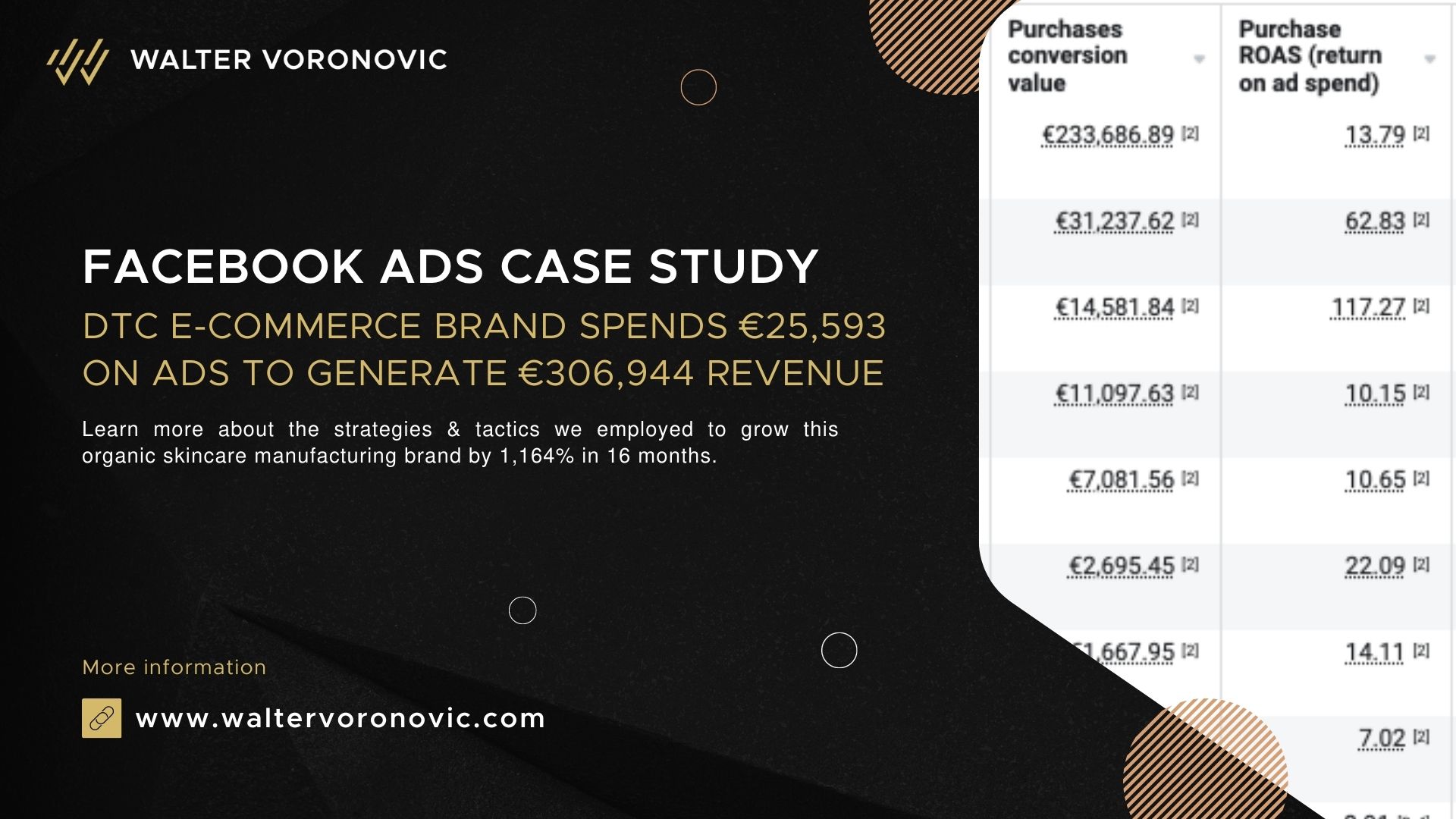
As the e-commerce industry grows, many brands are moving away from traditional distribution channels towards a direct-to-consumer approach due to its many benefits.
For this reason, an organic skincare manufacturing brand decided to grow its e-commerce revenue via paid Facebook and Google ads campaigns.
My primary responsibility was to acquire as many customers & revenue from the allotted ad budget as possible.
This client had already worked with an advertising agency, and they were successful in generating traffic & product page views but were unsuccessful in driving significant & measurable revenue growth.
We didn’t have access to the ad accounts, tracking pixels, or extensive creative performance reports, as everything was done in-house by the agency on their ad accounts.
It also meant we’d have to do all the research, strategy, creative strategy & technical setup from scratch due to the lack of previous account history.
Effective advertising is essential for DTC e-commerce brands to thrive in a competitive market. It drives customer acquisition, fuels growth, and builds brand awareness.
Our goal was customer acquisition & revenue growth. We chose Facebook as our primary customer acquisition channel because I’m most experienced with this platform & the Google display network for remarketing.
Our strategy consisted of two main parts – volume testing & sales/discount campaigns.
To execute both parts successfully, we also needed to test & find the best-performing audiences & campaign structure/setup, create compelling & highly converting ad creatives, and implement accurate & reliable tracking mechanisms to monitor campaign performance.
The first step to success was to find products we could sell consistently at the regular price.
To find these products, we tested each product line (seven in total), product (90+) & service offering, and different audiences, landing pages & creative approaches.
Once we had the winning campaign structure, audience, products, landing pages & ad creatives, we could run these ads to consistently & predictably generate revenue throughout the year.
We also ran four major sales/discount/bundle offer campaigns in Q3 & Q4.
These campaigns aimed to attract a broader audience, win over people on the fence & spike revenue in a short time frame – max four-day sales campaigns.
Campaign structure – I always start from the campaign goal and work backward.
If our aim is customer acquisition, setting up a conversion/sales campaign optimized for the purchase conversion event makes the most logical sense.
Audiences – we didn’t have enough purchase event data to create a lookalike audience, so we started with a Facebook lookalike audience from the customer email list, 30-day website visitors, and a broad audience (women, 25-55).
We tested each audience in a separate ad set to find the best-performing options.
We started with simple product photos for images and the AIDA (Attention, Interest, Desire, Action) copywriting framework for the ad copy.
The idea is to create the best version we can with the available resources without wasting time and improve with each new batch of ads.
It’s an iterative process beneficial to smaller companies with minimal layers of approval that can execute fast.
Once we have results from the first tests, we can create better & more compelling ad creatives.
Throughout the whole process, we tested these approaches:
Creating highly converting ad creatives is the #1 factor to success – the prospective customer has to view & click the ad before they check out the product on your site.
Even before iOS 14.5 update and the user privacy directives, Facebook’s native ad tracking wasn’t the most reliable or accurate.
After these changes, Facebook implemented the aggregated event measurement, so setting up accurate ad-tracking software was as relevant as ever.
To address this problem, we implemented these measures:
The execution starts with client meetings, discussion of responsibilities & overall strategy.
Then we evaluate common ad policy violations to avoid & successful creative approaches along with the correct image/video sizes.
The next step is to pick the first batch of products for testing, landing pages to send traffic to, ad creatives to run & also set up ad accounts & tracking systems.
Our process looked like this:
After our initial testing period, the best campaign structure was – one conversion campaign optimized for the purchase event, one ad set targeting a broad audience (women, 25-55) with 50 euros per day budget, and many individual ads (50+) linking to product categories & specific product pages.
I’ve included a quick video with the results to showcase their authenticity.
Total users acquired – 123,378
Sessions – 230,624
E-commerce conversion rate – 2.35%
Transactions – 5,422
Revenue from all traffic sources – €306,944.90
Revenue from Facebook ads (last click attribution) – €45,336.45
Revenue from Google Display Network – €16,918.51
 Total ad spend – €21,961.18
Total ad spend – €21,961.18Purchase conversion value – €305,544.78
Link clicks – 54,384 total
Cost per link click – €0.40 per action
CTR – 0.78% per impression
Purchases – 6,198
Ad spend – €3,596.95
Clicks – 75,391
Cost per link click – €0.05
CTR – 0.96%
Purchases – 330.00 (Google ads data)
Total revenue growth compared to the previous period – 1,164.36%
As we can see in the image above, Google’s organic revenue grew by 1,435%, with only a 3.63% increase in user acquisition without a significant investment in SEO or content.
It indicates that most people don’t buy on the first visit but rather second or third.
Our main challenge at the start of this project was we didn’t know which product offers would sell consistently, so we adopted a volume-testing strategy and short sales/discount campaigns to attract a broader audience.
This strategy yielded great results and can be effectively utilized for smaller, growth-focused companies.
If you’re looking for a long-term marketing partnership, feel free to reach out here or schedule your free 15-minute consultation.